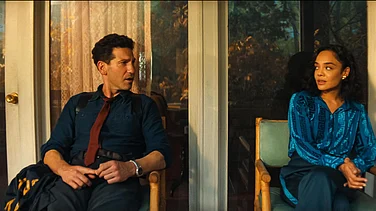There are items made of cast iron, copper-wire and mud. Body-building items such as casted-iron dumbbells, martial sports laathis (sticks); kitchen articles such as scissors, stoves, knives and scrapers, and tools of labour such as hammer, shovel and wrench are welded together to give them some shape.
Bengaluru-based artist Archana Hande’s installation ‘My Kottige’, which is showcased at the Kochi-Muziris Biennale, is her innovative take on changing times, urbanisation and rejection of the unwanted, both things and people. She arranges “discarded” things as a “witness” of their time and space.
Hande has given a second life to ‘scrap’ items she collected from Gujri market—a local flea market in Bengaluru. She has sculpted them into totem-like pillars and jharokhas (hanging windows and lattice) to structure together a new urban space, her kottige (space or identity in her native languages Kannada and Tulu). “These are discarded archives of the city,” says Hande.
Philosophy of Art
Her contrasting experiences as a child and adult—memory of her Brahminical grandparents and ancestral village during her vacations where she went as a child against her own cosmopolitan upbringing in an industrialised town while living with her parents—frame the backdrop for the philosophy of her art. Her installation is a protected space. She doesn’t allow viewers to enter that space. They can only glimpse through spy holes, windows and glasses.
Hande’s installation is also a take on women’s search for their own spaces. However, it is not exhaustive to one identity. Caste and class also feature highly in her narrative of spaces. The Gujri market in Bengaluru provides her the tools for that metaphor in the urban sense.
Garadi Mane, which are traditional wrestler’s dens or akharas (wrestling arena) for pehelwans (wrestlers), are today modernised into gymnasiums, just like the fate suffered by many other old practices. The old-fashioned equipment of these wrestling enclosures, located within the Gujri, are discarded and sold to the flea market, which are being pushed to the periphery or disintegrating due to the push by real estate. In these markets, these discarded objects witness a gradual fall in status. From everyday items of utility, they are relegated to the position of urban waste in an ever-changing urban space and commercialisation.
Women have been traditionally kept out of these akhara spaces, a metaphor for many other spheres of life and society. “They can enter the akhara only once a year only to change the mud,” says Hande. In another sense, for her, the casted iron items, though changed in status, stand obstinate, like patriarchy.
Hande says her art is inspired by these tools, her sense and her visual language. “I am not a writer. I cannot sing. So, this is my tool. I understand visuals. I can understand and express art through that visual language,” she explains her technique.
“It is about the “thought of being discarded,” she says. The talk of failure and rejection provides a philosophical background to her collection where she uses “rejected things as a witness.” It’s similar to the way we discard people for some reason or another.
Hande goes on to narrate a local belief system of discarding images of gods, which she finds amusing. Some people believe that the photo frames of gods and deities must be discarded after ten years because they lose their power.
Her engagement with the idea of being discarded stands in contrast with her other work with nomadic people, salt traders and camel traders, who she says don’t believe in the idea of rejection. “They pick up and add clothes wherever they travel,” she says.
It is true that for Hande, her kottige, as a space and identity, has a bearing of her gender. But she says it also incorporates other identities of class and caste, in a world where the idea of space is constantly changing. Each one of the viewers could interpret the kottige from their own lens and perspectives. “I was creating my own space. It was the initiation of my own personal spaces. I have looked at women spaces a lot and used that material as a metaphor. Even in the city life, every second person tries to show you your place. But not your space,” she says.
Bhoota Sthana: A Ghost Shrine
For ‘My Kottige’, Hande traces inspiration and material from her childhood memory of going to visit her grandparents in their ancestral rural house in coastal Karnataka during her summer vacations. Her work is a yearning to form a contemporary space for herself, her own bhoota sthana, a ghost shrine.
The phrase bhoota sthana evokes the folk imagination of a revered spirit god known to be always drunk and stoned. Her grandmother used to tell her about the Kalu-Kudka (drunk ghost), who was supposed to save people from evil and harm but was also feared by all.
During her childhood, sailing with the Dalit boatman or drinking ginger-soda from a low caste vendor was considered blasphemy for Brahmins like her in her ancestral village. Only the drunken-spirit Kalu-kudka, whose idol was a black stone, could rise above caste and gender hierarchies, as he was worshiped by both, her puritanical grandmother, as well as by those considered ‘untouchables’ by the caste system.
Nobody could take the spirit god home. He lived publicly in the bhoot sthana. Hande says that her bhoota sthana is as porous and playful as that of the Kalu-Kudka. “While I was a kid, I took Kalu-Kudka as a protector. We were not scared of him. If I went to a Dalit’s house or to a fisherman, my grandmother would scold me. In Rourkela, my father never taught us that there is a difference between caste and class,” she says.
Hande marks the installation site with these object-sculptures as her own ‘Bootha Sthana’, a shrine that would protect the environment from the nazr (evil eye) of contemporary social conflicts–conflicts between genders, classes, castes and sexual identities. She calls this bhoota sthana a “phantom space”.
So, can art help each one of us find our own bhoota-sthanas? “Art can only make people question and can be a record of our times,” says Hande.
(This appeared in the print edition as "The Phantom SPACE")


























